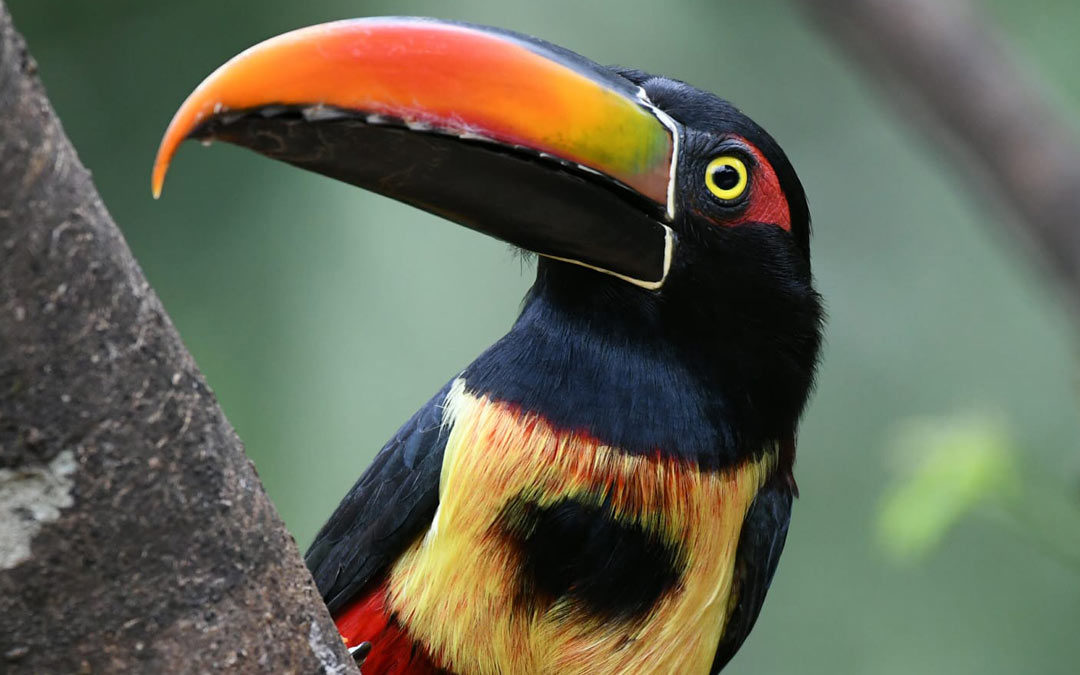Toucans are known for their vibrant plumage and distinctive bills. These colorful birds inhabit the tropical forests of Central and South America.
Toucans, with their striking colors and large, curved bills, are among the most recognizable birds in the world. Native to the lush, tropical forests of Central and South America, these birds captivate bird enthusiasts and nature lovers alike. Their vivid feathers, ranging from bright yellows to deep blues, serve as both camouflage and a means of attracting mates.
Toucans are not only visually stunning but also play a vital role in their ecosystem by helping to disperse seeds. This guide explores the fascinating world of toucans, shedding light on their habitats, behaviors, and the unique characteristics that make them so enchanting.
Toucans: A Splash Of Color In The Treetops
Toucans are among the most colorful birds in the world. Their vibrant feathers and unique beaks make them a sight to behold. These birds are not just beautiful; they are also fascinating creatures with a lot to offer.
Tropical Habitats And Distribution
Toucans live in tropical forests of Central and South America. They thrive in lush, green environments with plenty of trees.
These birds are often found in countries like Brazil, Colombia, and Costa Rica. They prefer high canopies where they can find fruits and insects.
Here is a table showing the distribution of various toucan species:
| Species | Region |
|---|---|
| Keel-billed Toucan | Mexico to Venezuela |
| Toco Toucan | Brazil, Argentina, Bolivia, Paraguay |
| Channel-billed Toucan | Northern South America |
Physical Attributes: More Than A Beak
Toucans are famous for their large, colorful beaks. But these birds have more unique features. Their beaks are lightweight despite their size, which helps in picking fruits.
They have strong legs and toes that help them grip branches. Their feathers come in a range of colors, from bright yellows to deep reds and greens.
Here are some key physical attributes of toucans:
- Beak: Large, colorful, and lightweight
- Feet: Strong legs with zygodactyl toes
- Feathers: Vibrant and multi-colored
The Iconic Beak: Form And Function
The toucan’s beak is a marvel of nature. It is vibrant and large. It serves many purposes beyond just eating. Let’s explore its wonders.
Adaptations For Feeding
Toucans have a unique feeding style. Their beaks help them reach fruits on thin branches. They can’t climb well, so the beak is essential. The beak is also light despite its size. This makes it easy for toucans to carry.
| Feature | Function |
|---|---|
| Length | Reach distant fruits |
| Lightweight | Easy to handle |
| Colorful | Attracts mates |
Role In Thermoregulation And Courtship
The beak also helps toucans stay cool. Blood flows through it to release heat. This process is called thermoregulation. The beak’s colors also play a role in courtship. Bright colors attract potential mates.
Here are some key points:
- Regulates body temperature
- Displays vibrant colors
- Attracts mates
- Blood flows to the beak
- Heat is released
- Mates are attracted by colors
The toucan’s beak is more than just a tool. It’s a survival device in many ways.
Feathers And Flight: Exploring Toucan Plumage
Toucans are known for their colorful feathers. These feathers help them blend into the rainforest. Let’s dive into the world of toucan plumage and explore the wonders of their feathers and flight.
Variations Across Species
Toucans come in many species. Each species has unique plumage. Below is a table showing some differences:
| Species | Plumage Colors |
|---|---|
| Keel-billed Toucan | Green, yellow, orange, blue |
| Toco Toucan | Black, white, orange |
| Ariel Toucan | Black, red, white, blue |
Each species’ feathers are different. These differences help them adapt to their environment. Their colorful plumage can also attract mates.
Molting Patterns And Maintenance
Toucans shed their feathers regularly. This process is called molting. Molting ensures their feathers stay healthy and vibrant. They molt in a specific pattern to keep flying.
The molting process can take months. Toucans lose a few feathers at a time. This gradual process helps them maintain flight balance.
Toucans preen their feathers daily. Preening keeps their feathers clean and aligned. They use their beaks to remove dirt and pests.
Healthy feathers are vital for flight. Toucans rely on their feathers for efficient flying. They also use their colorful feathers to communicate with other toucans.
- Preening – Toucans clean their feathers daily.
- Molting – Gradual feather shedding for health.
- Flight – Feathers are crucial for balance.
Understanding toucan plumage is fascinating. Their feathers are more than just colorful. They play a key role in their survival and communication.

Credit: www.costaricafocus.com
Toucan Diets: Fruits, Berries, And Beyond
The diet of toucans is as vibrant as their feathers. These birds feast on an array of foods. While fruits and berries make up a large part of their diet, they eat more than just that. Understanding their eating habits helps us appreciate their role in the ecosystem.
Favorite Foods And Foraging Behavior
Toucans love fruits and berries. Their bright beaks help them reach the ripest fruits. They often eat figs, guavas, and papayas. Toucans also enjoy berries and other small fruits.
Toucans are skilled foragers. They hop from branch to branch, searching for tasty treats. They use their long beaks to pluck fruits and berries from trees. They can eat foods that other birds cannot reach.
| Food Type | Examples |
|---|---|
| Fruits | Figs, Guavas, Papayas |
| Berries | Blueberries, Strawberries |
| Other | Insects, Small reptiles |
Impact On Seed Dispersal And Forest Health
Toucans play a key role in seed dispersal. After eating fruits, they fly to other places. They then excrete the seeds in different spots. This helps new plants grow in various areas of the forest.
By spreading seeds, toucans help forests stay healthy. New plants grow, providing food and shelter for many animals. This keeps the ecosystem balanced and thriving.
Without toucans, fewer seeds would spread. Forests would struggle to grow and stay healthy. These vibrant birds are essential for a balanced ecosystem.
Social Birds: Toucan Behavior And Communication
Toucans are not just colorful; they are also very social. These birds have unique ways of interacting with each other. Understanding their behavior and communication can be fascinating.
Vocalizations And Sound Repertoire
Toucans have a wide range of vocalizations. Each sound serves a different purpose. They use calls to communicate with their flock. Some sounds are used to warn of danger. Others help them find mates.
Here is a table of common toucan sounds:
| Sound | Purpose |
|---|---|
| Grunts | Social bonding |
| Rattles | Alarm calls |
| Clicks | Communication with mates |
Flocking And Social Structure
Toucans live in small groups called flocks. A flock usually has around six to twelve birds. They stay close to each other for safety. Flocks help them find food and protect each other.
Here are some important aspects of toucan social structure:
- Flocks have a clear hierarchy
- Dominant birds lead the flock
- Young birds learn from older ones
Observing toucans is a treat. Their social interactions are complex yet fascinating. These vibrant birds have much to teach us.
Nesting Habits Of Toucans
Toucans are not only known for their bright beaks but also their unique nesting habits. These birds have adapted to make the most out of their forest homes. Let’s dive into how toucans nest and care for their young.
Tree Cavities As Homes
Toucans often use tree cavities as their homes. These cavities provide safety from predators. The birds do not create these cavities themselves. They find natural holes in trees. Sometimes they use old woodpecker nests. The cavity size is just enough for the toucans to fit.
Inside, toucans keep their nests simple. They don’t add much material. The cavities are usually several meters above the ground. This height gives them an excellent vantage point.
Parental Roles And Chick Development
Both parents share responsibilities in raising the chicks. They take turns incubating the eggs. Incubation lasts around 16 days. After hatching, the chicks are blind and featherless.
Parents feed the chicks with fruit and insects. The feeding continues for about 6 weeks. During this time, chicks grow rapidly. Their beaks start to develop color. By 8 weeks, the young toucans are ready to leave the nest.
| Stage | Description |
|---|---|
| Incubation | Both parents incubate eggs for 16 days. |
| Chick Feeding | Parents feed chicks fruit and insects for 6 weeks. |
| Fledging | Chicks are ready to fly at 8 weeks old. |
- Tree cavities provide safe nesting spots.
- Both parents share incubation duties.
- Chicks are fed by parents for 6 weeks.
Conservation Efforts For Toucan Populations
Toucans are known for their bright colors and large bills. These birds live in tropical forests, but their numbers are decreasing. Conservation efforts aim to protect these beautiful birds.
Threats To Survival
Toucans face many threats in the wild. The biggest threat is habitat loss. Forests are being cut down for farming and logging. When trees are gone, toucans lose their homes.
Another threat is illegal pet trade. People capture toucans and sell them as pets. This reduces the number of toucans in the wild.
Climate change also affects toucans. Changing weather patterns can destroy their food sources. Without food, toucans cannot survive.
| Threat | Description |
|---|---|
| Habitat Loss | Forests are cut down for farming and logging. |
| Illegal Pet Trade | People capture and sell toucans as pets. |
| Climate Change | Changing weather patterns destroy food sources. |
Initiatives And Success Stories
Many groups are working to save toucans. One important step is protecting forests. Organizations buy land to create protected areas. These areas are safe for toucans to live and breed.
Education programs also help. People learn about toucans and why they need protection. When people understand, they are more likely to help.
There are some success stories. For example, some toucan populations are growing. This is because of reforestation projects. Trees are planted, and forests grow back. Toucans return to these new forests.
- Protected Areas: Safe places where toucans can live and breed.
- Education Programs: Teach people about the importance of toucans.
- Reforestation Projects: Planting trees to rebuild forests.
By working together, we can save these vibrant birds. Every effort counts in the colorful world of toucans.

Credit: www.shutterstock.com
Birdwatching Tips: Finding And Observing Toucans
Birdwatching is a fun way to see nature. Toucans are a favorite bird to watch. Their bright colors make them easy to spot. Follow these tips to find and observe toucans.
Best Times And Places To Spot Toucans
Toucans live in tropical areas. You can find them in rainforests. The best places to see toucans are Central and South America. Countries like Brazil and Costa Rica are ideal.
The best time to see toucans is early morning. They are active at dawn. Also, late afternoon is good. They come out to eat and play.
Look for toucans near fruit trees. They love to eat fruit. You might also see them near rivers and streams. They like to drink water.
Ethical Birdwatching Practices
Respect the birds and their home. Stay on marked paths. Do not disturb the trees or plants.
- Keep your distance from the birds.
- Use binoculars to see them up close.
- Do not feed the toucans.
Be quiet. Loud noises scare birds. Speak softly and walk slowly.
Take only pictures and leave only footprints. Do not take anything from the forest.
| Best Places | Best Times |
|---|---|
| Brazil | Early morning |
| Costa Rica | Late afternoon |
Follow these tips to enjoy birdwatching. You will love seeing toucans in their natural habitat.
Photographing Toucans: Capturing Their Brilliance
Photographing toucans is an exciting adventure. These birds are vibrant and full of life. Capturing their colors and personality requires the right approach.
Equipment Recommendations
To photograph toucans, you need the right gear. Here are some equipment recommendations:
| Equipment | Description |
|---|---|
| DSLR or Mirrorless Camera | High resolution and fast shutter speed |
| Telephoto Lens (300mm+) | For close-up shots from a distance |
| Tripod | Keep your camera steady |
| External Flash | Enhance lighting in dense forests |
| Memory Cards | Store lots of high-resolution photos |
Techniques For Vibrant Images
To capture the brilliance of toucans, use these techniques:
- Patience: Wait for the right moment.
- Lighting: Use natural light to highlight colors.
- Focus on Eyes: Sharp eyes make a photo engaging.
- Background: Choose a clean, contrasting background.
- Action Shots: Capture toucans in flight or feeding.
With the right gear and techniques, your toucan photos will shine. These birds are a joy to photograph. Happy shooting!

Credit: www.amazon.com
Toucans In Culture And Mythology
The vibrant colors and unique bills of toucans have fascinated humans for centuries. These birds often appear in various cultural tales and artistic works. This section explores the symbolic significance of toucans and their representation in art and literature.
Symbolic Significance Across Cultures
Toucans hold special meanings in many cultures. In some South American tribes, toucans are seen as spiritual messengers. They believe the bird connects the living with the spirit world. In other cultures, the toucan symbolizes communication and showmanship. Its loud calls and colorful appearance make it a natural symbol for these traits.
In modern culture, toucans often represent tropical beauty and exotic adventures. Brands use toucan imagery to evoke a sense of paradise and leisure. The bird’s vibrant colors and striking appearance make it an excellent symbol for these themes.
Toucans In Art And Literature
Toucans have inspired many artists and writers. Their bright feathers and unique bills make them popular subjects in paintings and sculptures. Artists often use toucans to add a splash of color and exotic flair to their works.
In literature, toucans appear in various stories and poems. Authors use the bird’s unique traits to symbolize creativity and individuality. Children’s books often feature toucans because of their playful and engaging appearance. The bird’s vivid colors and fun personality make it a favorite among young readers.
Here is a table summarizing the toucan’s symbolic significance in different cultures:
| Culture | Symbolic Significance |
|---|---|
| South American Tribes | Spiritual messenger |
| Modern Culture | Tropical beauty, exotic adventures |
| Art and Literature | Creativity, individuality |
Toucans also appear in media and advertising. Brands like Fruit Loops use a toucan mascot to attract attention. The bird’s colorful appearance and friendly demeanor make it perfect for marketing campaigns.
The toucan’s presence in culture and art highlights its universal appeal. Its vibrant colors and unique characteristics continue to inspire and captivate people worldwide.
Frequently Asked Questions
What Do Toucans Eat?
Toucans primarily eat fruits, but they also enjoy insects and small animals. Their diet includes berries, figs, and small reptiles.
Where Do Toucans Live?
Toucans are native to Central and South American rainforests. They thrive in the dense canopy layers of tropical forests.
How Long Do Toucans Live?
Toucans typically live between 15 to 20 years in the wild. In captivity, they can live up to 25 years.
Why Are Toucans’ Beaks So Large?
Toucans’ large beaks help them reach and eat fruit. The beak also aids in thermoregulation and attracting mates.
Conclusion
Exploring the world of toucans reveals their vibrant colors and unique behaviors. These stunning birds captivate bird enthusiasts worldwide. Learning about their habitats and diets can enhance your appreciation. Protecting their environments ensures future generations can admire these remarkable creatures.
Dive into the colorful world of toucans and discover nature’s wonders.











